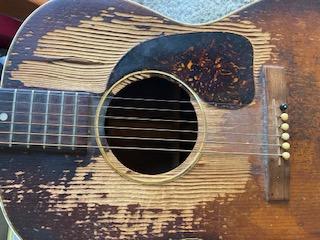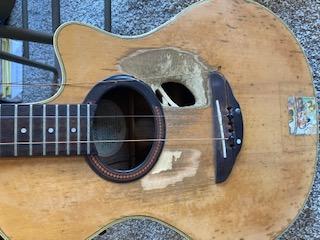 Dear Friends of Switchback, A friend of mine, Sheila Walk, sent along an article from the Texas Monthly. It was a story about Willie Nelson and his guitar, Trigger. Willie is one of those icons every musician would love to share the stage with. We came close, but instead opened for the Moody Blues. It would be great to share the stage with Willie, not only to sing with him, but to check out that fabled guitar of his. Guitars are important “tools of the trade” for musicians. Ironically, they sometimes happen to look like the most abused of tools. But it isn’t neglect that is on display. It is in constant use. A well worn guitar becomes almost a part of the musician holding it. Switchback has had a lot of guitars over the years. And, unlike Trigger, some of our guitars have had to go out to pasture. Mainly because of the way we play. Anyone watching a Switchback concert can see the amount of energy and effort that goes into getting a large sound out of a small instrument. The picks, the fingernails, the constant touring, all leave a mark on the pine tops and wear through whatever varnish to slowly etch into the wood. Brian’s Gibson, a 1950’s vintage guitar, was one of the first ones we had in the Wailin’ Banshees, our Irish band. It was a wonderful sounding guitar, with a smooth neck. We pulled it out of service as it wasn’t wired and the wood was slowly getting to where the sound of the guitar was getting affected. |
 The next guitar was my Yamaha that I purchased in 1986. This guitar had a composite back and a wood front. I still have it and I loaned it to Brian as we went on the road as Switchback. It slowly was starting to fall apart as our gigs increased. One problem was that Brian had heavy gauge strings installed on all his instruments. The neck pressure alone slowly would bend the guitar and wreak havoc on the braces. A couple of emergency repairs told us that the guitar wasn’t going to keep going. And I wanted to keep it relatively intact. We bought a second Yamaha. That guitar Brian had for a long time and it was that guitar that eventually wore a big hole near the sound hole. The brace was exposed and eventually as the sound got sweeter, the guitar became weaker. We bought a Taylor to back up the Yamaha. The Taylor was fine, but it didn’t have that snarl that the Yamaha could create when the duo was onstage. So we bought our third Yamaha, Blackie. Blackie is the main Yamaha these days, though the Taylor with its mellow sound does get used. |
 Brian had one mandolin for about 33 years, the Kentucky mandolin he bought to study with Jethro Burns. Unfortunately, that mandolin also began to disintegrate from steady, hard playing. That mandolin held up through storms, two kids having a tug of war with it and living in a cloth bag. It had a charmed life. But alas, it wasn’t to last. It was still going strong when in August of 2018 a mic stand accidentally fell on it, hitting the mandolin exactly in the bridge and snapping the brace. The luthier sadly shook his head as another instrument was brought to him on life support. Luckily, he had a spare mandolin that Brian loaned and then was bought by the band. That mandolin had a surprisingly smooth sound that was very much like the Kentucky mandolin. Brian had one mandolin for about 33 years, the Kentucky mandolin he bought to study with Jethro Burns. Unfortunately, that mandolin also began to disintegrate from steady, hard playing. That mandolin held up through storms, two kids having a tug of war with it and living in a cloth bag. It had a charmed life. But alas, it wasn’t to last. It was still going strong when in August of 2018 a mic stand accidentally fell on it, hitting the mandolin exactly in the bridge and snapping the brace. The luthier sadly shook his head as another instrument was brought to him on life support. Luckily, he had a spare mandolin that Brian loaned and then was bought by the band. That mandolin had a surprisingly smooth sound that was very much like the Kentucky mandolin. People always wonder why musicians agonize over losing instruments. In many ways, they not only become repositories of each show, but also an extension of your own personality. And they also become, like the possessor of the instrument, art itself. I am amazed that Willie Nelson has been able to keep that guitar of his going through the years. I am sure that there are many luthier stories about it and what it has taken to keep it onstage and in tune. And in a way, they will be around long after we are gone. It’s a tough call on whether or not an instrument should be hanging on a wall or kept going in someone’s hands. For our part in Switchback, hanging an instrument on the wall is putting Trigger out of its misery. You hate to do it, but there’s a lot more riding ahead. Thanks for making it a WayGood World! Marty |
